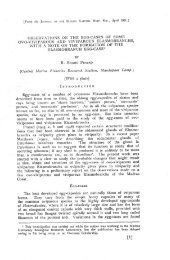PDF - Eprints@CMFRI
PDF - Eprints@CMFRI
PDF - Eprints@CMFRI
You also want an ePaper? Increase the reach of your titles
YUMPU automatically turns print PDFs into web optimized ePapers that Google loves.
160<br />
Genus Solenosmilia DUNCAN, 1873<br />
Type species: Solenosmilia variabilis DUNCAN , 1873.<br />
G e n e ric c h a r act e r s: DUNCAN (1873: 327) defined the genus thus: "The corallum is bushshaped<br />
; and the corallites, which rarely unite, are cylindrical and bifurcate. The terminal calices are<br />
produced by a bi-gemmation; and their fossae and columellae are in common. The tissue between the<br />
new calices is usually costulate, and that over the rest of the corallum granular and without any epitheca.<br />
The calices increase by fissi parity, and form occasionally shon series. Septa numerous, and not very<br />
exsen. Dissepimems common".<br />
Solenosmilia variabilis DUNCAN, 1873<br />
SolenosmiliIJ variDbilis 1873 , DUNCAN , 328 ; pI. 42111 - 18 (Type localit ies : East coast o f PonugaJ and Gulf of Cadiz).<br />
1881 . MOSELEY. 181, pI. 9/1 - S.<br />
jeffrey ;<br />
19042, v. MARENZELLER. 310 ; pI. 15 /4. 42.<br />
1939. GARDINER & WAUGH . 229.<br />
1914, ZIBROWIUS, 768 (synonymy).<br />
1980. ZIBROW1 US. 143 , pI. 7S /A- N.<br />
1898. ALCOCK. 27 , pI. 3/ 3. 3a. b.<br />
GARDINER & WAUGH (1939) recorded this species from southern Red Sea from a depth of 366 m<br />
(Stat. 209), hence its inclusion in the presem work. We had no opponunity to study any material.<br />
The following details of the species are based on ALCOCK (1898). Dendroid, calices projecting, the<br />
terminal ca lyx shows incomplete fission with a common fossa and columella. Diameter of the corallites<br />
about 4 mm, so much deep, elliptical or polygonal. Septa in three complete cycles with a few of the<br />
founh. All speta narrow, only slightly projecting, cycles not conspicuously demarcated. Septal faces<br />
granular, edges straight or wavy. Columella composed of thin, twisted processes. Costae rugiform at the<br />
distal pan of the coraUite, weak below.<br />
Dis t rib uti 0 n: Red Sea; Natal; South Africa ; Persian Gulf; West coast of India; Southeast Australia;<br />
North and South Atlamic; Amilles.<br />
Rem a r k s : According [0 ZIBROWIUS (1974) S. jeffreyi ALCOCK , originally described from the<br />
West coast of India, is the same as the Atlantic species S. variabilis.<br />
Genus Dasmosmilia POURTALES, 1880<br />
Ty pes p e c i e s : Trochosmilia Iymani PO URTALES, 1871.<br />
G e n e ri c c h a r act e r s : "Turbinate or trochoid, commonly increasing by parricidal budding.<br />
Paliform lobes before all but last cycle. Columella formed by mingling of inner lobes" (WELLS , 1956:<br />
F 429).<br />
Dasmosmilia valida v. MARENZELLER , 1906<br />
Damrosmilia vldidIJ 19062, v. MARENZELLER, 18 ; pI. 2/2, 2a, b (Type local ity : Red SC'a).<br />
We have no specimen in the presem collection. But MARENZELLER (1906a) has collected this species<br />
in the northern Red Sea at a depth of 490 m (Star. 179). For details reference may be made [0 him .<br />
Distr i bution : Red Sea .<br />
Subfamily Eusmiliinae MILNE EDWARDS and HAIME, 1857<br />
Synopsis of the genera of Eusmiliinae :<br />
I. Corallum mainly phaceloid with divergi ng branches. Co raBit es mono-(:emric or in valleys. Septa little<br />
exsert. Columella absem ..... ... . ... ..... ..... .. ..... . ..... . ........ . ..... . . Euphy/lia
















